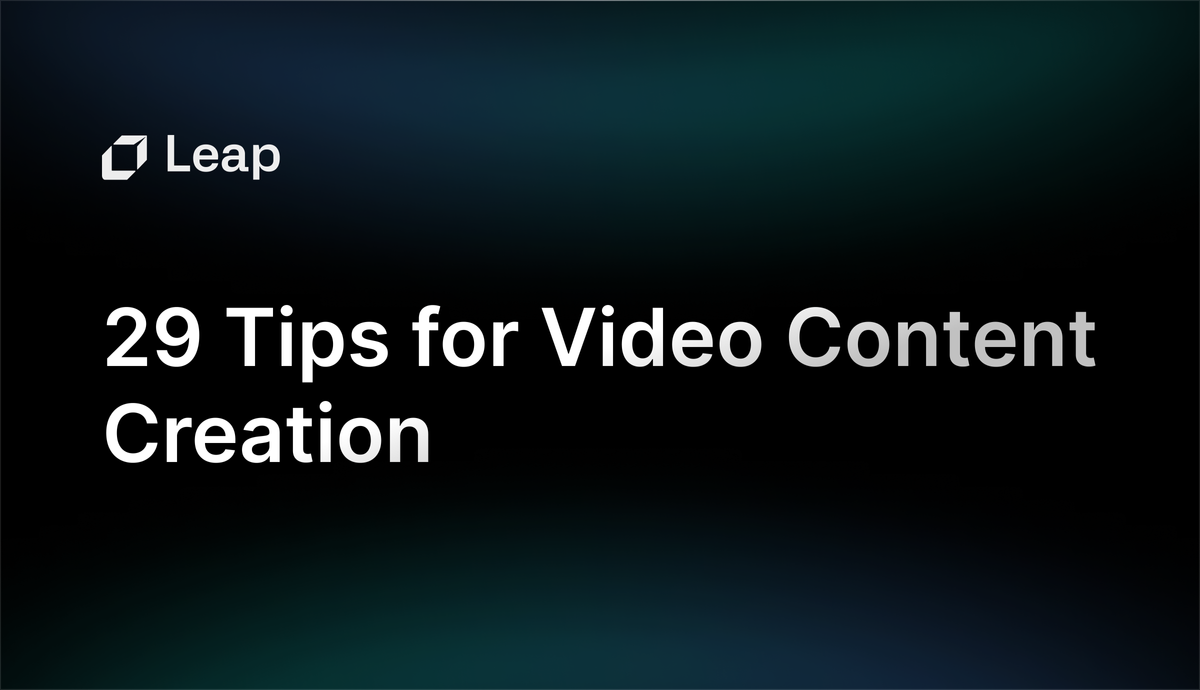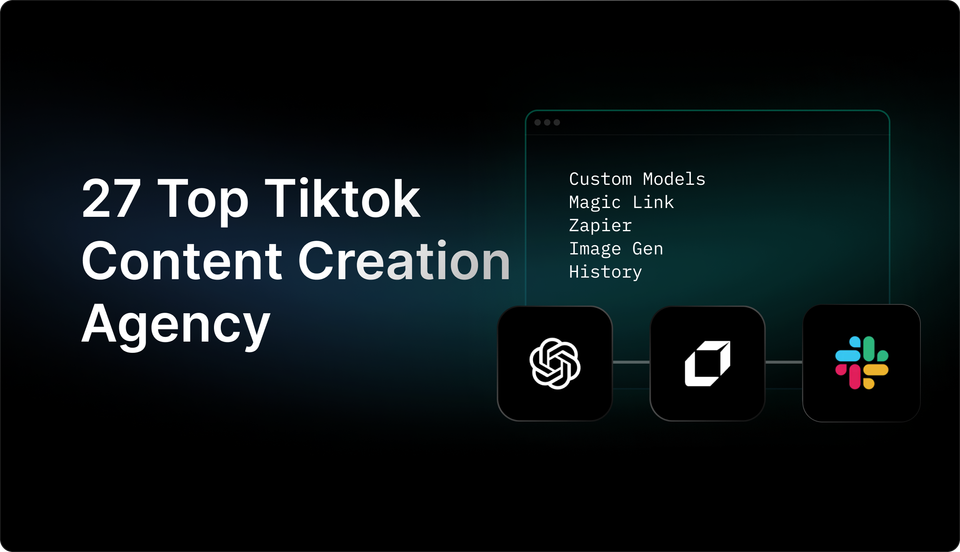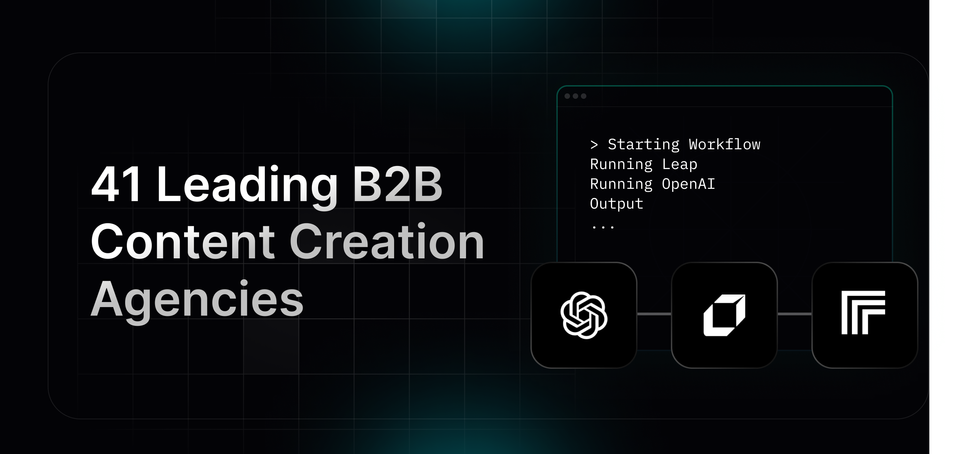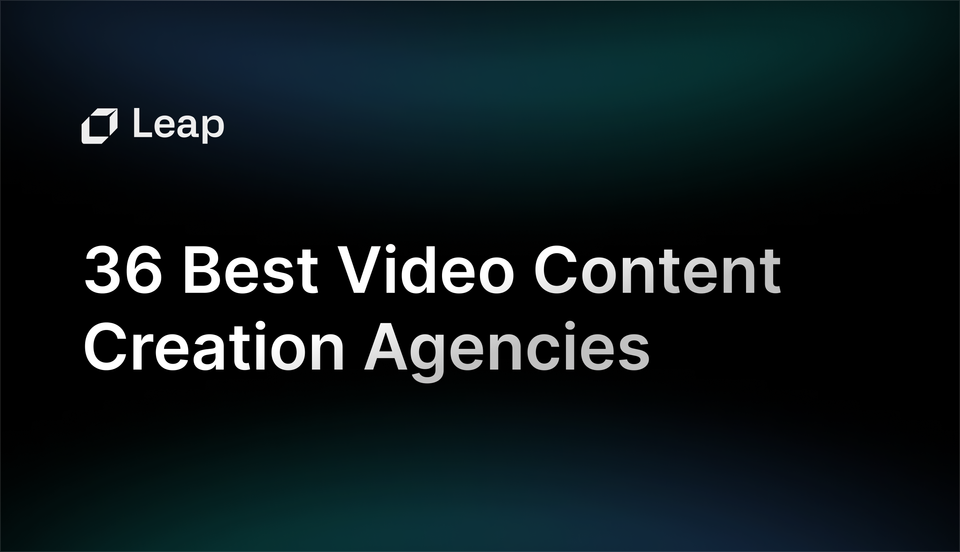29 Tips for Video Content Creation & Free AI Video Content Creation Tool
Ignite engagement with compelling Video Content Creation. Elevate the brand with visually stunning videos. Unleash your storytelling prowess now!

In the age of digital media, the demand for captivating and engaging video content creation is at an all-time high. From social media platforms to websites and streaming services, video content has become a powerful tool for individuals and businesses alike to convey their message and connect with their audience. But what does it take to create compelling video content that stands out from the crowd?
In this blog, we will explore the art and science of video content creation, from planning and scripting to filming and editing. Whether you're a seasoned videographer or a novice looking to dip your toes into the world of video creation, this blog will provide you with the tips and tricks you need to create stunning videos that captivate and inspire. So, grab your camera and let's dive into the exciting world of video content creation!

What Is Video Content Creation & Why Is It Important for Businesses?

Video content creation has become a vital tool for businesses to engage with their target audience and drive meaningful connections. With the rise of social media platforms and the increasing popularity of video-sharing websites like YouTube and TikTok, businesses can no longer afford to overlook the power of video as a marketing strategy.
What Is Video Content Creation?
Video content creation refers to the process of planning, producing, and distributing videos that convey a specific message or story. It involves various elements, including scripting, filming, editing, and adding visual effects or animations. Video content can take many forms, such as brand videos, product demos, tutorials, testimonials, event coverage, or even behind-the-scenes glimpses. Here's why video content creation is crucial for businesses:
1. Enhanced Engagement
Videos have the ability to captivate and hold the attention of viewers in a way that other forms of content cannot. They offer a dynamic and immersive experience by combining visuals, audio, and motion. Businesses can leverage this engaging medium to deliver their message in a more memorable and impactful way, ultimately leading to higher audience engagement and retention.
2. Increased Reach
With the proliferation of social media platforms and video-sharing websites, videos have the potential to reach a vast audience. When businesses create compelling video content, they have the opportunity to go viral and attract attention from thousands, if not millions, of viewers. This wider reach can significantly boost brand awareness and attract potential customers.
3. Improved Search Engine Optimization (SEO)
Search engines, like Google, prioritize video content in their search results. By incorporating video into their websites and social media channels, businesses can improve their search engine rankings and visibility. Videos tend to keep visitors on a website for longer durations, reducing bounce rates and signaling to search engines that the content is valuable.
4. Effective Storytelling
Video content allows businesses to tell their brand story in a more engaging and authentic way. Through visuals, emotions, and narratives, businesses can connect with their target audience on a deeper level. By presenting their products or services within a meaningful context, businesses can create a lasting impression and build trust with potential customers.
5. Versatility and Adaptability
Video content can be repurposed and distributed across multiple platforms, maximizing its reach and impact. Whether it's sharing snippets on social media, embedding videos in blog posts, or including them in email marketing campaigns, businesses can leverage video content in various ways to cater to different audience preferences.
Video content creation is an essential strategy for businesses looking to stand out in the digital landscape. With its ability to engage, reach, and tell compelling stories, video content has become an indispensable tool for businesses of all sizes and industries. Don't miss out on the opportunity to harness the power of video to drive your business forward.
Revolutionize Video Content Creation
Ready to explore the world of video content creation? Try Leap's AI Workflows tool for free today and revolutionize the way you automate your work with the power of AI. Supercharge your video content creation process and unlock endless possibilities for your business, all without writing a single line of code.
Partnered with Zapier, Vercel, and other leading platforms, Leap empowers you to create sophisticated AI automations and connect the tools you love with best-in-class AI models. Take the leap and elevate your video content creation game now!
Related Reading
- Artificial Intelligence Content Creation
- Content Creation Process
- Facebook Content Creation
- Content Creation Examples
- Content Creation Strategy
- Content Creation Ideas
- Social Media Content Creation
- Ai Content Creation
Figuring Out Your Target Audience for Video Content

When creating video content, businesses need to identify and understand their target audience in order to create content that resonates with them. Here are some steps that can help businesses determine their target audience for video content:
1. Market Research
Conduct thorough market research to gather insights about potential customers. This includes analyzing demographics, psychographics, and behavior patterns. Look into factors such as age, gender, location, interests, preferences, and purchasing behavior.
2. Analyze Existing Customers
Examine the characteristics and preferences of your existing customer base. Identify common traits, motivations, and pain points. This can provide valuable information about the target audience for your video content.
3. Define Your Value Proposition
Clarify your unique selling proposition (USP) and the value your product or service offers. This will help you understand the specific needs and desires of the audience that will benefit the most from your content.
4. Competitor Analysis
Study your competitors' video content and their target audience. Look for gaps or opportunities that you can leverage to reach a specific niche audience.
5. Use Analytics Tools
Utilize analytics tools to gain insights into your website and social media analytics. Look at metrics like user demographics, engagement rates, and conversions to understand who is already interacting with your brand.
6. Conduct Surveys and Interviews
Reach out to your existing customers or potential target audience through surveys, interviews, or focus groups. Ask questions about their preferences, needs, and expectations regarding video content.
7. Test and Refine
Create different types of video content and test them with different segments of your target audience. Collect feedback and adjust your content strategy based on the results.
By following these steps, businesses can effectively determine their target audience for video content. Understanding the target audience is crucial for creating engaging and relevant videos that will resonate with viewers.
Tailored Video Content
Ready to create video content that speaks directly to your target audience? Leap helps you automate your work with the power of AI, making it easier than ever to create custom AI automations. Try Leap's AI Workflows tool for free today and supercharge your video content creation process.

29 Tips for Video Content Creation

1. Define Your Goals
Clearly establish what you want to achieve with your video content, whether it's brand awareness, lead generation, or sales conversion.
2. Know Your Audience
Research and understand your target audience's demographics, interests, and pain points. Tailor your content to resonate with them.
3. Plan Your Content Strategy
Develop a comprehensive plan that aligns with your goals and speaks to your audience's needs. Create a content calendar to stay organized.
4. Storytelling is Key
Craft compelling narratives that captivate your viewers and evoke emotions. Use storytelling techniques to engage your audience on a deeper level.
5. Keep it Concise
Capture attention quickly and maintain it by keeping your videos concise. Shorter videos are more likely to be watched in their entirety.
6. Optimize for Mobile
Since mobile devices are now the primary way people consume video content, ensure your videos are mobile-friendly with vertical or square formats.
7. Hook Viewers from the Start
Make your opening seconds count. Start with an attention-grabbing hook that entices viewers to continue watching.
8. Invest in Quality Equipment
While you don't need Hollywood-level gear, invest in decent cameras, microphones, and lighting to ensure your videos look and sound professional.
9. Use Good Lighting
Proper lighting can significantly enhance the visual quality of your videos. Natural light or affordable lighting kits can make a big difference.
10. Capture Clear Audio
Invest in a good microphone or a lapel mic for clear and crisp audio. Poor audio quality can ruin an otherwise great video.
11. Create Engaging Thumbnails
Design eye-catching and relevant thumbnails that compel viewers to click on your videos. Use visually appealing images and compelling titles.
12. Utilize Captions and Subtitles
Incorporate captions and subtitles to make your videos more accessible and reach a wider audience, including those who watch without sound.
13. Implement Branding Elements
Consistently include your brand logo, colors, and fonts in your videos to reinforce brand recognition and create a cohesive visual identity.
14. Incorporate Calls-to-Action (CTAs)
Encourage viewers to take action by including clear and compelling CTAs throughout your videos. Guide them toward conversions.
15. Publish Regularly
Consistency is key. Publish videos on a regular schedule to build anticipation, maintain engagement, and grow your audience.
16. Leverage SEO Techniques
Optimize your video titles, descriptions, and tags with relevant keywords to improve search rankings and attract organic traffic.
17. Be Authentic and Relatable
Show your personality and connect with your audience on a personal level. Authenticity helps build trust and loyalty.
18. Use Emotional Appeals
Appeal to your audience's emotions to create a memorable impact. Make them laugh, cry, or feel inspired to take action.
19. Include Testimonials
Share customer testimonials and success stories in your videos to build credibility and showcase the value of your products or services.
20. Educational Content
Provide valuable information or teach your audience something new. Educational videos establish you as an authority in your industry.
21. Collaborate with Influencers
Partner with influencers or industry experts to expand your reach and gain credibility. Their endorsement can significantly boost your video's impact.
22. Encourage User-Generated Content
Engage your audience by encouraging them to create and share their own videos related to your brand. User-generated content builds a sense of community.
23. Leverage Social Media Platforms
Publish and promote your videos on popular social media platforms like YouTube, Instagram, Facebook, and LinkedIn to reach a wider audience.
24. Monitor Analytics
Regularly review the performance analytics of your videos to gain insights into viewer behavior, preferences, and engagement. Use this data to refine your strategy.
25. Experiment with Different Formats
Explore various video formats such as tutorials, interviews, behind-the-scenes, or product demonstrations to keep your content fresh and engaging.
26. Engage with Your Audience
Respond to comments and engage with your viewers to foster a sense of community and build brand loyalty.
27. Repurpose Content
Extend the lifespan of your videos by repurposing them into other formats such as blog posts, podcasts, or social media snippets.
28. Analyze Your Competitors
Study your competitors' video content to gain inspiration and identify gaps you can fill with your unique approach.
29. Stay Updated with Trends
Keep an eye on emerging trends and adapt your video content accordingly to stay relevant and capture the attention of your target audience.
Empowering Work with Leap's Partnered AI Workflows
Leap helps you to automate your work with the power of AI. Partnered with Zapier, Vercel, and more, Leap enables you to supercharge your work by allowing you to create custom AI automations. Create sophisticated AI automations with no-code. Connect the tools you love with best-in-class AI text, image, and audio models.
Supercharge your existing tools with seamless AI integrations to OpenAI, Microsoft, and more. From summarizing documents, to voice translation, to AI call transcription, to AI avatar and asset generation, to SEO automation, automate anything with Leap Workflows. The opportunities for automation are endless with Leap workflows.
Try Leap’s AI Workflows tool for free today.
How To Incorporate Storytelling Into Your Video Content

Storytelling has long been a powerful tool for captivating audiences and creating emotional connections. When it comes to video content creation, incorporating storytelling can significantly enhance the impact of the message conveyed. By telling a compelling story, businesses can engage viewers on a deeper level, evoking emotions that resonate with their target audience.
1. Identifying the Central Theme
The first step in incorporating storytelling into video content is to identify the central theme or message. This theme should align with the brand's values and resonate with the target audience. Whether it's a brand origin story, a customer success story, or a narrative that highlights the benefits of a product or service, the central theme should be relatable and meaningful.
2. Developing Relatable Characters
To create emotional appeal, it is essential to develop relatable characters within the video content. These characters can be employees, customers, or even fictional representations. By showcasing their struggles, aspirations, and triumphs, viewers can connect with the characters, fostering empathy and emotional engagement.
3. Creating a Narrative Arc
A strong narrative arc is crucial for holding viewers' attention and building emotional tension. The video content should have a beginning, middle, and end, following a logical progression that keeps viewers invested. This arc can include introducing a problem or conflict, showcasing the journey towards a solution, and ultimately providing a resolution that aligns with the central theme.
4. Utilizing Visual Storytelling Techniques
In addition to verbal storytelling, visual storytelling techniques can enhance the emotional appeal of video content. Incorporating captivating visuals, such as evocative imagery, vibrant colors, and creative camera angles, can evoke specific emotions and enhance the overall impact of the story. The use of music, sound effects, and voiceovers can further enhance the emotional experience.
5. Leveraging Emotional Triggers
To create emotional appeal, it is essential to tap into universal emotions that resonate with the target audience. Whether it's joy, sadness, hope, or inspiration, leveraging emotional triggers can create a powerful connection between the video content and the viewers. By understanding the values and desires of the target audience, businesses can craft narratives that evoke the desired emotional response.
6. Providing a Call to Action
While storytelling and emotional appeal are essential, it is also crucial to provide a clear call to action within the video content. After captivating viewers and eliciting an emotional response, businesses should provide a clear next step for the audience, such as visiting a website, making a purchase, or sharing the content with others. This call to action ensures that the emotional connection is not lost and can lead to further engagement or conversions.
Incorporating storytelling and emotional appeal into video content creation can transform the way businesses connect with their target audience. By identifying the central theme, developing relatable characters, creating a narrative arc, utilizing visual storytelling techniques, leveraging emotional triggers, and providing a call to action, businesses can create impactful video content that leaves a lasting impression.
Creative Ways To Repurpose Existing Video Content

Repurposing existing video content can be a cost-effective and efficient way for businesses to reach new audiences and maximize the value of their content. Here are some creative ways businesses can repurpose and leverage their existing video content:
1. Create Short Clips for Social Media
Break down longer videos into shorter clips that are ideal for sharing on social media platforms like Instagram, Twitter, and TikTok. These bite-sized videos can capture attention quickly and are more likely to be shared, helping to expand your reach and engagement.
2. Transform Videos into Blog Posts
Transcribe the audio from your videos and use it as the basis for blog posts. This allows you to reach audiences who prefer reading over watching videos and improves the search engine optimization (SEO) of your website by adding valuable written content.
3. Develop Tutorials and How-To Guides
If your videos demonstrate a process or provide instructions, repurpose them into tutorials or how-to guides. This can be done by adding written instructions and screenshots to accompany the video, creating comprehensive guides that cater to different learning styles.
4. Turn Videos into Podcast Episodes
Extract the audio from your videos and repurpose them as podcast episodes. This allows you to tap into the growing popularity of podcasts and reach audiences who prefer audio content. You can also add additional commentary or interviews to enhance the podcast experience.
5. Create Video Teasers
Take snippets of your existing videos and create teaser videos to generate excitement and anticipation for upcoming releases or events. These teasers can be shared on social media, embedded in emails, or used as pre-roll advertisements to generate buzz and drive traffic.
6. Compile Highlights and Bloopers
Gather the most entertaining or impactful moments from your videos and compile them into highlight reels or blooper compilations. These types of videos tend to be highly shareable and can help humanize your brand by showing a more lighthearted and relatable side.
7. Customize for Different Platforms
Adapt your videos to suit the specific requirements and preferences of different platforms. For example, create vertical or square versions for mobile viewing, add captions for silent viewing on social media, or optimize videos for different aspect ratios to ensure they look their best on each platform.
By repurposing and leveraging existing video content, businesses can extend their reach, engage with different audiences, and maximize the value of their content. Embrace the power of video content and explore these creative strategies to supercharge your marketing efforts.
Unleash Automation Potential
Leap helps you to automate your work with the power of AI. Partnered with Zapier, Vercel, and more, Leap enables you to supercharge your work by allowing you to create custom AI automations. Create sophisticated AI automations with no-code. Connect the tools you love with best-in-class AI text, image, and audio models.
Supercharge your existing tools with seamless AI integrations to OpenAI, Microsoft, and more. From summarizing documents, to voice translation, to AI call transcription, to AI avatar and asset generation, to SEO automation, automate anything with Leap Workflows. The opportunities for automation are endless with Leap workflows.
Try Leap's AI Workflows tool for free today.
Related Reading
- Ugc Content Creation
- Content Marketing Content Creation
- Content Creation Seo
- Content Marketing E Commerce
- Content Creation Workflow
- Ai Social Media Content Creation
- Content Creation Tips
- B2b Content Creation
- Content Creation For Instagram
- Ai Video Content Creation
- How To Use Chatgpt For Content Creation
- Content Creation Ideas For Youtube
- Content Creation Ideas For Tiktok
- Content Creation Ideas For Instagram
Measuring The Success of Your Video Content Creation Efforts

In the world of video content creation, businesses invest time, effort, and resources to produce compelling videos that resonate with their target audience. The true measure of success lies in the ability to gauge the effectiveness of these videos. Here are some key metrics and strategies that can help businesses measure the impact of their video content:
1. View Count and Engagement
The number of views a video receives is a good starting point, but it doesn't provide the full picture. Engagement metrics such as likes, shares, comments, and watch time are equally important. These metrics indicate how well the video is capturing the attention and interest of viewers.
2. Click-Through Rate (CTR)
If a video is part of a larger marketing campaign, tracking the CTR can provide insights into its effectiveness. By monitoring how many viewers actually click on a call-to-action or visit the website after watching the video, businesses can assess the video's ability to drive viewer action.
3. Conversion Rate
Ultimately, businesses want their video content to drive conversions. Tracking the conversion rate can help determine if the video is successfully converting viewers into customers or achieving other desired outcomes, such as lead generation or newsletter sign-ups.
4. Social Media Analytics
Social media platforms provide valuable analytics on video performance. Metrics such as reach, impressions, and follower growth can offer insights into the video's impact on brand visibility and audience engagement.
5. Audience Feedback and Sentiment Analysis
Collecting and analyzing audience feedback through comments, surveys, or social listening tools can provide qualitative insights into how viewers perceive and respond to the video content. Sentiment analysis can help identify positive, negative, or neutral sentiments associated with the video.
6. Return on Investment (ROI)
Calculating the ROI of video content involves assessing the cost of production, distribution, and promotion against the benefits it generates. This could include revenue generated, cost savings, brand recognition, or customer loyalty.
7. A/B Testing
Conducting A/B tests with different versions of a video can help determine which elements (e.g., length, tone, call-to-action) are more effective at achieving the desired outcomes. By comparing metrics between the versions, businesses can optimize their video content for better results.
By leveraging these metrics and strategies, businesses can gain valuable insights into the success and effectiveness of their video content. This knowledge can inform future content creation efforts and help achieve better outcomes.
Experience Seamless Automation with Leap's AI Workflows
Leap helps you to automate your work with the power of AI. Partnered with Zapier, Vercel, and more, Leap enables you to supercharge your work by allowing you to create custom AI automations. Create sophisticated AI automations with no-code. Connect the tools you love with best-in-class AI text, image, and audio models.
Supercharge your existing tools with seamless AI integrations to OpenAI, Microsoft, and more. From summarizing documents, to voice translation, to AI call transcription, to AI avatar and asset generation, to SEO automation, automate anything with Leap Workflows. The opportunities for automation are endless with Leap workflows.
Try Leap’s AI Workflows tool for free today.
Create Game Changing Automations Today With Leap’s AI Workflows
Automating your work processes can drastically improve productivity and efficiency. With the help of Leap, a cutting-edge AI automation platform, you can supercharge your video content creation and streamline your workflow like never before. By integrating the power of AI into your existing tools, you can create custom automations that save you time and effort, while producing high-quality content that resonates with your audience.
Automate Anything with Leap Workflows
Leap Workflows allows you to automate a wide range of tasks related to video content creation. Whether you need to summarize documents, translate voice recordings, transcribe AI calls, generate AI avatars and assets, or automate SEO tasks, Leap has got you covered. The possibilities for automation are truly endless, and you can tailor your workflows to suit your specific needs.
Seamless Integration with Your Favorite Tools
Leap integrates seamlessly with popular tools like Zapier and Vercel, enabling you to connect the tools you love with best-in-class AI text, image, and audio models. You can easily integrate with OpenAI, Microsoft, and other leading AI providers, expanding your options and unlocking even more powerful automation capabilities. With Leap, you can leverage the strengths of multiple tools and AI models, combining them to create a workflow that suits your unique requirements.
AI-Powered Summarization and Translation
Creating compelling video content often involves researching and summarizing large volumes of information. With Leap's AI-powered summarization capabilities, you can quickly extract key insights and synthesize information from documents, articles, and other sources. This saves you time and allows you to focus on creating impactful content.
Leap's voice translation feature enables you to translate voice recordings from one language to another with remarkable accuracy. This is especially valuable if you work with international clients or have a global audience.
Accurate AI Call Transcription
Transcribing audio recordings can be a tedious and time-consuming task. Leap simplifies this process by automating AI call transcription. Whether you're conducting interviews, recording meetings, or capturing important conversations, Leap's AI models accurately transcribe the audio, saving you hours of manual effort.
AI Avatar and Asset Generation
Give your video content a unique and professional touch with AI-generated avatars and assets. Leap's AI models can create realistic avatars, logos, and graphics to enhance your videos and make them stand out. This opens up a world of creative possibilities, allowing you to produce visually captivating content without the need for expensive design software or graphic designers.
Streamline SEO Automation
Optimizing your video content for search engines is crucial for reaching a wider audience. Leap can automate various SEO tasks, such as keyword research, meta tag optimization, and content analysis. By leveraging AI, you can ensure that your videos are discoverable and rank higher in search engine results, ultimately driving more traffic to your content.
Try Leap's AI Workflows Tool for Free Today
If you're ready to take your video content creation to the next level, why not give Leap's AI Workflows tool a try? With its intuitive interface and powerful automation capabilities, Leap empowers you to work smarter, not harder. Unlock the potential of AI and experience the benefits of seamless integration, time-saving automations, and enhanced content quality.
Sign up for a free trial of Leap Workflows today and revolutionize your video content creation process.
Related Reading
- Content Creation Tools
- Content Creation Agency
- Content Creation Software
- Automated Content Creation
- Ai Tools For Content Creation
- Social Media Content Creation Services
- Social Media Content Creation Agency
- Best Content Creation Apps
- Seo Content Creation Services
- Digital Content Creation Tools
- Social Media Content Creation Tools
- Video Content Creation Agency
- B2B Content Creation Agency
- Tiktok Content Creation Agency
- Content Creation Marketing Agency




